Comprehensive Guide to C4 Herniated Disc: Diagnosis and Management
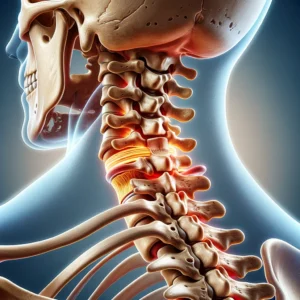
A C4 herniated disc is a medical condition affecting the cervical spine, particularly the fourth cervical vertebra, known as C4.
This condition occurs when the soft center of a spinal disc, the nucleus pulposus, bulges or breaks through the tougher, outer layer, leading to compression or irritation of the nearby nerve roots or the spinal cord itself.
Such herniations are not uncommon in the cervical region, where the spine experiences a significant range of motion and bears the weight of the head.
The cervical spine, consisting of seven vertebrae (C1-C7), plays a pivotal role in supporting the head and facilitating its movements.
The C4 vertebra, situated in the middle of the cervical spine, along with its intervertebral disc, is crucial for the neck's flexibility and strength. A herniated disc at this level can significantly impact a person's quality of life due to the discomfort and functional limitations it can cause. One of the first options is to seek an expert spine specialist surgeon such as Dr. Baker who can assist you.
While herniated discs can occur anywhere along the spine, those in the cervical region, particularly at the C4 level, are noteworthy due to the area's sensitivity and the critical structures it houses. This condition can lead to various symptoms, including neck pain, stiffness, and potentially radiating pain or numbness in the shoulders, arms, or even down to the fingers, depending on the severity and specific nerve involvement.
Understanding C4 herniated discs is crucial for both healthcare professionals and patients alike. It involves not only recognizing the symptoms but also appreciating the complex nature of the cervical spine and the potential impact on overall spinal health.
As we delve deeper into this topic, we will explore the anatomy of the cervical spine, the mechanics of disc herniation, symptoms, and the various treatment options available for those affected by this condition.
Worried About Your C4 Disc?
Request an Appointment
Anatomy of the Cervical Spine
Understanding the Cervical Vertebrae Structure
The cervical spine, a key component of the human skeletal system, is intricately designed to support the head's weight and enable its diverse range of movements.
This section of the spine comprises seven vertebrae, labeled C1 to C7. Each cervical vertebra plays a vital role in protecting the spinal cord and contributing to the neck's mobility and stability.
Focus on C4: A Critical Segment of the Cervical Spine
Among these, the C4 vertebra holds significant importance. Located in the middle of the cervical spine, it serves as a pivotal point, facilitating neck rotation and bending.
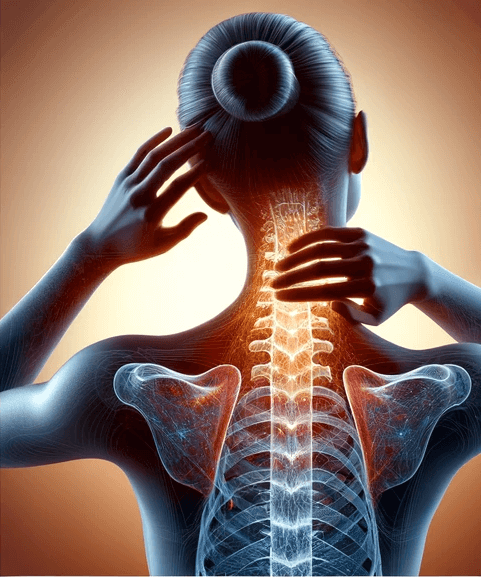
The C4 vertebra, along with its adjacent discs, is crucial in maintaining the overall alignment and balance of the neck and head.
Intervertebral Discs: The Cushions of the Spine
Sandwiched between the vertebrae are the intervertebral discs, acting as shock absorbers and allowing smooth, pain-free movements of the spine.
These discs consist of a tough, fibrous outer layer (annulus fibrosus) and a soft, gel-like center (nucleus pulposus). The health and integrity of these discs are essential in preserving the spine's function and preventing neurological complications.
C4's Role in Spinal Health and Function
The C4 disc, in particular, bears the responsibility of cushioning the impact between the C3 and C4 vertebrae. Its health is crucial for preventing cervical spine disorders, including herniated discs, which can lead to pain and reduced mobility.
Understanding the anatomy and function of the C4 vertebra and its disc is fundamental in diagnosing and treating related spinal conditions effectively.
The Importance of Maintaining Disc Health
Maintaining the health of the intervertebral discs, especially in the cervical spine, is paramount for overall spinal wellness. Degeneration or injury to these discs, such as a herniation at the C4 level, can lead to significant discomfort and functional impairment, underscoring the importance of spinal health in our daily lives.
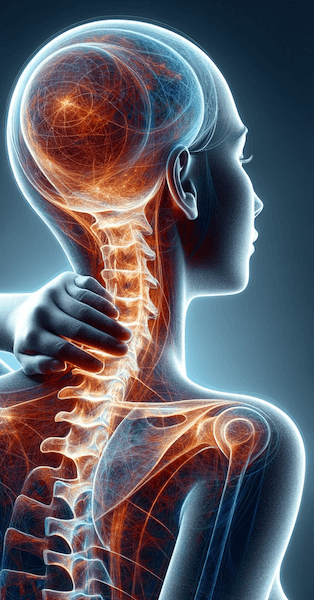
How a Cervical Disc Herniates
The Process of Disc Herniation in the Cervical Spine
Understanding how a cervical herniated disc occurs is crucial in comprehending the associated pain and complications.
A herniated disc, often referred to as a slipped or ruptured disc, occurs when the soft, gel-like center of the intervertebral disc (nucleus pulposus) pushes through a tear in the tough, fibrous outer ring (annulus fibrosus).
Mechanism of Herniation in the Cervical Region
This herniation commonly affects the cervical spine, which consists of the seven vertebrae in the neck region. The cervical discs, especially in the C4-C5 and C5-C6 levels, are particularly susceptible due to the spine's flexibility and the significant motion it endures.
When a cervical disc herniates, it can impinge on the spinal nerves or spinal cord, leading to symptoms like neck pain, arm pain, and radicular pain.
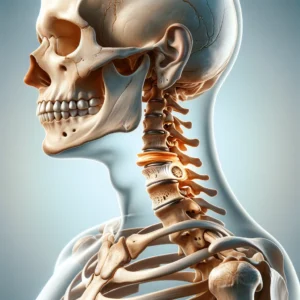
Contributing Factors to Cervical Disc Herniation
Several factors can contribute to the herniation of a cervical disc. These include age-related wear and tear, neck injury, poor posture, and repetitive strain.
Age-related degeneration causes the annulus fibrosus to lose its strength and elasticity, making it more prone to tearing. Physical trauma or excessive strain on the neck can expedite this process, resulting in a herniated cervical disc.
Herniated Cervical Discs: Impact on Spinal Health
When a cervical disc herniates, it can compress the nearby nerve root or even the spinal cord itself. This compression can result in cervical radiculopathy, characterized by pain and neurological symptoms radiating into the arms.
In more severe cases, compression of the spinal cord (spinal cord dysfunction) can occur, potentially leading to symptoms like muscle weakness, loss of bowel or bladder control, and coordination difficulties.
Importance of Early Identification and Treatment
Early identification and treatment of a herniated cervical disc are vital to prevent further complications and to ensure effective pain management.
Non-surgical treatments like physical therapy, cervical traction, and muscle relaxers often provide significant pain relief. However, in cases where conservative treatment is ineffective, surgical treatments such as anterior cervical discectomy may be necessary.
The Role of Medical Imaging in Diagnosis
Diagnostic tools like CT scans and nerve conduction studies play a crucial role in confirming the presence and extent of a herniated disc.
These studies help health professionals, including orthopedic surgeons and physical therapists, to tailor a comprehensive treatment plan for the individual patient, aiming for optimal recovery and spinal health.
Identifying C4 Herniated Disc Symptoms
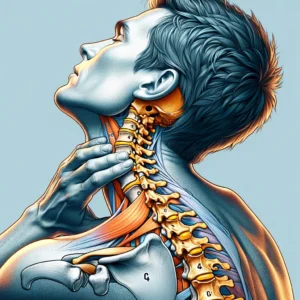
Recognizing Symptoms of a C4 Herniated Disc
A C4 herniated disc can manifest a range of symptoms, which are crucial for early identification and effective treatment. Understanding these symptoms aids in distinguishing a C4 herniation from other neck injuries or conditions.
Key Indicators of a C4 Herniation
- Neck Pain and Stiffness: One of the primary indicators of a herniated cervical disc, including at the C4 level, is neck pain. This pain may be persistent and could worsen with movement.
- Radicular Pain: Patients often experience radicular pain that radiates from the neck to the shoulder and possibly to the upper arm. This is due to the compression of the nerve root by the herniated disc material.
- Muscle Weakness and Spasms: The pressure exerted on the spinal nerve or nerve root can result in muscle weakness, often noticeable in the upper arm. Muscle spasms may also occur, further contributing to discomfort.
- Sensory Changes: Some individuals may experience altered sensations like tingling or numbness in the affected arm, indicating nerve involvement.
Differentiating C4 Herniation from Other Neck Conditions
- Location and Nature of Pain: While general neck pain can arise from various conditions, the specific pattern of radiating pain is more indicative of a herniated disc.
- Symptomatic Cervical Radiculopathy: The presence of radiculopathy, which involves nerve root compression leading to radiating pain and neurological symptoms, is a key differentiator.
- Response to Conservative Treatment: If symptoms like neck and arm pain respond positively to nonsurgical treatments such as physical therapy or cervical traction, it may point towards a herniated disc as opposed to other neck injuries.
- Medical Imaging Confirmation: A CT scan or other diagnostic imaging can confirm the presence of a herniated disc, differentiating it from conditions like cervical disc disease or muscle strain.
Importance of Accurate Symptom Identification
Accurate identification of symptoms is vital for effective management. Whether it's through nonsurgical treatments, pain relief measures, or considering surgical options like anterior cervical discectomy, understanding the symptoms ensures targeted and efficient treatment. Patients with cervical herniated disc symptoms should seek consultation with a spine specialist or an orthopedic surgeon for proper diagnosis and treatment planning.
Causes and Risk Factors of Cervical Herniated Discs
Understanding the Underlying Causes of Cervical Disc Herniations
Cervical herniated discs occur when the soft material inside the disc (nucleus pulposus) protrudes through a tear or weakness in the outer part of the disc. This herniation can compress nearby nerve roots or the spinal cord, leading to symptoms.
Common Causes of Cervical Herniated Discs
- Degenerative Disc Disease: Age-related wear and tear is a common cause. As discs age, they lose hydration, making them more susceptible to tearing and herniation.
- Physical Strain or Injury: Sudden, intense pressure from activities like heavy lifting or an abrupt movement can cause herniation. Neck injuries from accidents or sports also contribute significantly.
- Postural Stress: Long-term poor posture can increase stress on the cervical spine, contributing to disc herniation.
Risk Factors Specific to C4 Herniated Disc
- Genetic Predisposition: A family history of spinal problems may increase the risk of developing a herniated disc.
- Occupational Hazards: Jobs that involve repetitive neck movements, heavy lifting, or vibration (like driving) can heighten the risk.
- Lifestyle Factors: Lack of regular exercise, smoking, and obesity are known risk factors that weaken disc health.
- Age and Gender: Middle-aged individuals are more prone to disc herniation, with a slightly higher incidence in men.
Recognizing Cervical Herniated Disc Symptoms
While cervical herniated disc symptoms can vary, common signs include neck pain, radiating arm pain (radicular pain), and neurological symptoms like numbness or weakness in the arms. These symptoms often start spontaneously and can be exacerbated by movements that put pressure on the herniated material.
Importance of Identifying Causes and Risk Factors
Understanding these causes and risk factors is crucial for both prevention and effective treatment. For those with symptomatic cervical herniated discs, interventions range from conservative treatments like heat therapy to more advanced options like artificial disc replacement, depending on severity and response to initial management strategies.
Identifying these elements can also guide pain specialists in devising appropriate pain relief methods and tailoring treatment plans to individual needs, considering factors like adjacent vertebrae health and overall spinal column condition.
Comprehensive Approach to Managing C4 Herniated Discs
A C4 herniated disc presents a complex challenge, demanding an in-depth understanding of cervical spine anatomy and the nuances of spinal health. Accurately identifying the symptoms and underlying causes is critical for effective management and treatment. This condition, which predominantly affects the cervical region, can significantly impact quality of life due to the discomfort and potential limitations it imposes.
Key to managing a C4 herniated disc is a holistic approach that includes early and accurate diagnosis, appropriate pain management strategies, and both conservative and surgical treatment options. Non-surgical methods like physical therapy, cervical traction, and muscle relaxers play a vital role in providing relief and improving mobility. However, in more severe cases, surgical interventions, such as anterior cervical discectomy, may become necessary.
Rehabilitation and post-treatment care are equally crucial for a full recovery. Engaging in physical therapy and making necessary lifestyle adjustments can significantly enhance the long-term well-being of patients. Furthermore, understanding the preventive measures to avoid future herniations is essential. Maintaining spinal health through regular exercise, proper posture, and a balanced diet can help mitigate the risk of recurrence.
Ultimately, living with a C4 herniated disc requires a comprehensive approach that not only addresses the immediate symptoms but also focuses on long-term spinal health and prevention. Regular consultations with healthcare professionals, including orthopedic surgeons and physical therapists, are imperative to manage this condition effectively. By adopting a proactive stance towards spine care and embracing a holistic treatment and preventive strategy, individuals can lead a more comfortable and active life despite the challenges posed by a C4 herniated disc.
Frequently Asked Questions
about C4 Disc Herniation
How Does a Cervical Herniated Disc Differ from a Lumbar Herniated Disc?
A cervical herniated disc occurs in the neck region of the spine, involving one of the seven cervical vertebrae. It primarily affects the spinal nerve roots near the neck and can lead to symptoms such as neck pain and arm pain. Cervical disc herniations often result in nerve compression, causing symptoms like radiating pain in the arms and possible neurological deficits.
In contrast, a lumbar disc herniation occurs in the lower back, within the lumbar spine region. This type of herniation typically impacts the spinal canal in the lower back and can lead to lower back pain, leg pain, or sciatica. The symptoms of lumbar herniation are generally more related to the compression of nerve roots that travel down into the legs, often leading to symptoms like numbness or weakness in the legs.
Both types of herniations can affect spinal health significantly but present different symptom profiles due to their locations in the spinal column.
Can a C4 Disc Herniation Affect Bowel Control?


Dr. Baker specializes in neurosurgery, neurosurgical spine surgery, neurotrauma, brain tumors, spinal tumors, and peripheral nerve damage treatment.